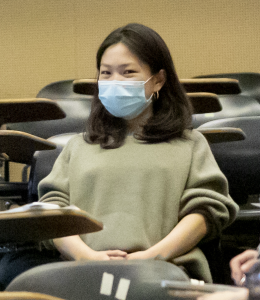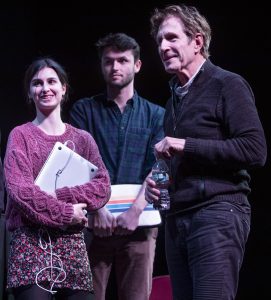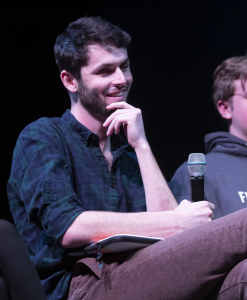By Audrey Soss (BFF 2022)
As bell hooks states in the introduction to her book Reel to Real, “Whether we like it or not, cinema assumes a pedagogical role in the lives of many people. It may not be the intent of a filmmaker to teach audiences anything, but that does not mean lessons are not learned” (2). Although the viewer’s goal may not be to learn and although the filmmaker’s intention may not be to teach, movies have the power to start discussions, raise questions, and engage an audience beyond the theater. In planning the Bates Film Festival, we prioritized several goals. A lot of care went into picking films that would stay with the viewer, and an equal amount of attention was focused on offering a slate of films that engaged a wide variety of topics. We wanted to inspire important discussions both at and outside of the festival, and we wanted to create dialogues that centered around issues of race, gender, sexuality, and class.
hooks also points out that “movies not only provide a narrative for specific discourses of race, sex, and class, they provide a shared experience, a common starting point from which diverse audiences can dialogue about these charged issues” (3). As a BFF programmer, I felt our primary goal was to create this starting point. As I considered our options, the following questions guided my decision making: “Which of the available films raise topics of particular interest to me and the BFF audience?” “Given the limited number of screening windows, how can our selections represent a variety of filmmakers, experiences, and perspectives?” “What does the audience want to see?” “What kinds of themes do I want the festival to spotlight?” These questions were vital, and they were mobilized in the planning, organization, and realization of the 2022 Bates Film Festival.
“For me, being able to witness abstract ideas come to life as real events within months or even weeks of their initial discussion was one of the most surreal elements of this experience.“
Now that the festival has concluded, it is important to reflect on the various decisions we made and the reasons behind those decisions. In the beginning, as with most film festivals, our goal was to define what our festival would be and decide what direction(s) we should take. Initially, this seemed like a daunting task simply because we had not yet seen many of the films we planned to consider. Throughout the first half of the semester, we screened two films, back-to-back, every Thursday night, and we also kept up with readings and various assignments. Because our time was limited, we had two programming teams – one for feature-length documentaries and one for feature-length fiction narratives. (As a result, there are still a few films that the other team considered that I have yet to be able to screen.) As we watched more films and as events and guests started to fall into place, the film festival began to take shape. Very quickly, we went from editing the mission statement at a class meeting in Pettigrew on the Bates campus to a panel discussion about diversity and representation in children’s media at Meetinghouse Arts in Freeport with Academy Award-winning filmmaker Bruce Smith (Bebe’s Kids) and the producers and director of the Emmy Award-winning Street Gang: How We Got to Sesame Street. For me, being able to witness abstract ideas come to life as real events within months or even weeks of their initial discussion was one of the most surreal elements of this experience.

Looking back on the festival planning process, my mind is often drawn to our method of programming. As a programmer, it was difficult for me to know what the audience would think of a film. That information only came available when I was sitting in a theater with them, watching them respond to a film we had chosen. Until then, I was guessing about what films they would like and which would start conversations. On the day we made our official selections, the two programming teams met. We voted on the films we had watched and then discussed our choices with one another. We shared our reasoning behind certain of our choices and argued in favor of or against the films that had less consensus among the group. This process opened conversations not only based on what we enjoyed and what we thought would spark valuable conversations but also on what we thought our audience would enjoy and what we thought they would be interested in discussing. In contrast to previous editions of the Bates Film Festival, this year we had to keep the Freeport audience in mind. That was an audience about which we knew very little, and our assumptions about their preferences played into both the films we selected and the scheduling choices we made. Some films played only at Bates; some films played only in Freeport, and some films played both at Bates and in Freeport. Ultimately, we found that our assumptions about the Freeport audience were not always correct and that they had different reactions to films than our class did. That is worth reflecting upon for future BFF programmers. In the years to come, what can BFF programmers do to understand audiences outside of the Bates community? Does the programming process need to remain the same or should it change depending on the audience(s) being considered? Now that we have had a year in Freeport, do we have a better understanding of that audience or can more work be undertaken to further understand their preferences?
“What stands out to me was the way in which our personal preferences and our desire to advance our advocacy work around a specific topic spurred our selections.”
In “Film Festivals: Successful or Safe?” Marijke de Valck considers whether the festival circuit “offer[s] a safe environment” that creates a greater appreciation “for the vulnerable films in our society,” or if it simply “allows filmmakers to remain marginal… while [the festival] simultaneously [loses] its ability to connect to the film world outside” (97). de Valck concludes that there is no straightforward answer to this question. The festival itself is “not only concerned with films and filmmakers, bestowing them with cultural value, but also with their own survival” (99). Although the original intent of the Bates Film Festival was to appreciate the art of screen media and storytelling, it’s important to consider how much of this process has become “a business transaction.” Bigger festivals often operate as a stepping stone to Hollywood and can therefore become interested in films that generate tickets sales at the festival, films that often conform to Hollywood norms. The Bates Film Festival is unlike these festivals in that it is free and open to the public, but at times, our selection process was influenced positively if we knew that a film under consideration had played at one or more of the bigger festivals. At the same time, we were drawn to films that had not screened at a larger festival. Our slate of films ranged from the “norm” (films that would be shown at other festivals and/or distributed by Hollywood studios) to the “unusual” (films that broke with that standard). What stands out to me was the way in which our personal preferences and our desire to advance our advocacy work around a specific topic spurred our selections.

For example, I was adamant about the inclusion of Marley Morrison’s Sweetheart. For me, the film went beyond the usual LGBT+ coming out narrative by focusing on a teenaged lesbian (AJ, played by Nell Barlow) who had already come out to her family. I found the story to be very touching and felt like it could start important discussions about lesbian representations. Sweetheart was well-reviewed and played at important festivals, but it did not screen at Sundance, Toronto, Telluride, Venice, or Cannes. While our festival thought highly of films that played at those premier venues, we also screened titles that followed a different path. This was important because each festival has its own selection process and its own priorities. For example, de Valck mentions that larger festivals often feel a need to constantly supply “discoveries” so that they can claim that their platform helped to secure the success of these films (100). This can lead the festival to focus more on what a submitted film can do for the festival’s standing within the industry, rather than the artistry or merits of the film itself. We wanted to create a slate of films that was unique to the BFF, its mission, its audiences, and its goals. There may not be a single answer to de Valck’s questions about whether film festivals are “safe” or “successful,” but speaking from my personal experience with the Bates Film Festival, I think that it’s important for festivals to program from multiple perspectives. That seems the surest way to craft a festival that cultivates both an appreciation of film and an awareness that film can be used to spur larger discussions.
“I experienced something amazing when I got to sit in a theater with an audience and watch a film that we programmed together as a team. I attended a variety of events at the 2022 Bates Film Festival, and after each, I walked away feeling that I had learned something new.“
Overall, the programming process for the Bates Film Festival was driven by the films that deeply moved us and the fact that the selections were made in a classroom environment. Some of the films played at bigger festivals; some did not. I learned that there are many ways to program a festival, and no one method is right all of the time. I learned that audience reactions are never predictable 100% of the time, and I experienced something amazing when I got to sit in a theater with an audience and watch a film that we programmed together as a team. I attended a variety of events at the 2022 Bates Film Festival, and after each, I walked away feeling that I had learned something new. It was a festival that I am proud to have organized.
Works Cited
de Valck, Marijke. “Film Festivals: Successful or Safe?” The Film Festival Reader, edited by Dino Iordanova. St. Andrews: St. Andrews Film Studies, 2013, pp. 97-108.
hooks, bell. Reel to Real: Race, Class, and Sex at the Movies. New York: Routledge, 1996.






